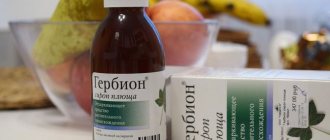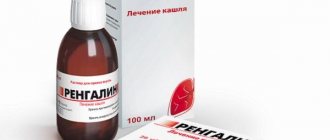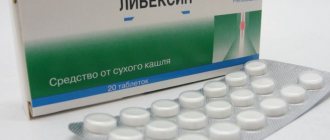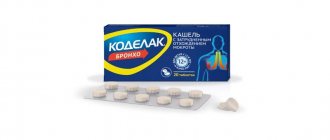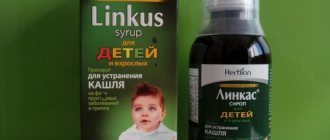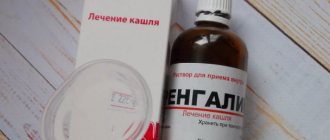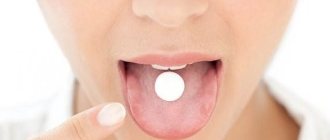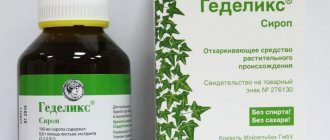Fluifort is a pharmaceutical product for oral administration. Available in several dosage forms. It belongs to the group of mucolytics, and therefore has a pronounced expectorant and mucus-thinning effect. Intended for the treatment of diseases of the bronchopulmonary system. Widely prescribed for adults and children.
Compound
1 packet of granules contains 2.7 grams of carbocisteine ( lysine salt ) and additional substances: cedar flavor, polyvinylpyrrolidone , mannitol , citric acid, orange juice powder and aspartame .
100 ml of syrup liquid contains 9 grams of carbocisteine and additional components: cherry flavor, sucrose, purified water, methyl parahydroxybenzoate, caramel.
special instructions
From the first days of taking the drug, due to improved secretion removal, the expectorant effect increases.
Fluifort in the form of granules for preparing a suspension contains a sweetener - aspartame. This substance is contraindicated in patients suffering from phenylketonuria.
Fluifort syrup contains sucrose. This should be taken into account by patients on a hypocaloric diet and patients with diabetes mellitus. With concomitant diabetes mellitus, it is necessary to take into account the sucrose content in the syrup: 5.25 g per 1 tablespoon (in a dose of syrup for adults) and 3.5 g per 1 teaspoon (in a dose of syrup for children).
The use of Fluifort does not lead to addiction or metabolic dependence.
Treatment can be combined with physiotherapeutic procedures.
Use during pregnancy and breastfeeding
Not recommended in the first trimester of pregnancy; breastfeeding should be stopped during treatment.
Interaction
Currently, there are no known cases of interaction between carbocisteine and drugs commonly used in the treatment of respiratory diseases.
There was no interaction between the drug and food, as well as substances used for laboratory research.
The effect is weakened by antitussive and anticholinergic drugs.
Increases the effectiveness of GCS (mutually) and antibacterial therapy for infectious and inflammatory diseases of the upper and lower respiratory tract.
Enhances the bronchodilator effect of theophylline.
For impaired renal function
Contraindicated in chronic glomerulonephritis in the acute phase.
pharmachologic effect
The medication has expectorant and mucolytic effects. The principle of action is based on the activation by carbocysteine of the enzyme sialic transferase, which is located in the mucous wall of the bronchi. The active substance of the drug normalizes the ratio of acidic and neutral sialomucins in sputum, improves elasticity and normalizes sputum viscosity.
During treatment, normalization of the ciliated epithelium is recorded, the structure of the mucous membranes is restored, and regeneration . The active component increases immunity (specific, nonspecific), enhances mucociliary clearance .
Indications for use
Fluifort is prescribed for diseases of the bronchopulmonary system (acute and chronic forms), accompanied by the formation of viscous secretion and difficult to separate sputum:
- bronchial asthma;
- bronchitis;
- bronchiectasis;
- tracheitis;
- tracheobronchitis.
The medication can be prescribed for pathology of the ENT organs , accompanied by the production of viscous mucus:
- otitis media;
- sinusitis;
- adenoiditis;
- rhinitis.
Cough powder can be prescribed before diagnostic procedures: bronchoscopy , bronchography .
Area of use
The range of uses for Fluifort cough syrup, as well as granules for preparing a suspension, is quite wide.
The drug is mainly prescribed for diseases of the respiratory system, namely:
- Bronchitis. The disease can be either chronic or acute.
- Whooping cough.
- Purulent and unspecified otitis media.
- Asthma of various types, including those with a predominance of the allergic component.
- Various types of otitis and more.
In addition, the drug can also be taken for ENT diseases. So, this drug is prescribed for inflammation of the middle ear, rhinitis and other ailments.
The main purpose of using Fluifort is to “translate” a dry cough into a wet one. The drug helps to liquefy mucus and remove it from the body as quickly as possible. As a result, breathing becomes easier and the process of healing from the underlying disease is accelerated.
The instructions for use also indicate some contraindications. First of all, the drug should not be taken if you are hypersensitive to the components that it contains. Also, the drug is not used for exacerbation of peptic ulcers of the gastrointestinal tract.
In addition, you should not take this medicine during the first three months of pregnancy.
There are also some moments when taking the drug described should be done with caution. This includes the second and third trimester of pregnancy, as well as the time of breastfeeding a newborn.
Contraindications
The drug is not prescribed for individual hypersensitivity to carbocysteine .
Cough syrup contains sucrose and is contraindicated in patients with diabetes mellitus .
The powder is not used in the treatment of patients suffering from phenylketonuria .
For ulcerative pathology of the digestive system, the medication is not prescribed.
In pediatric practice, syrup can only be used in the treatment of children from 1 year of age (granules - from 16 years of age).
Release form
"Fluifort" in the form of syrup is a dark yellow liquid that smells like cherries. It is transparent and has a syrupy semi-liquid consistency. This drug is sold in bottles made of glass. To prevent the medicine from deteriorating under the influence of sunlight, such glass has a dark color.
One bottle of Fluifort contains 100 ml of medicine. In the box, along with the bottle, there is a paper note and a dosage cup, on which marks 2.5 ml, 5 ml, 10 ml and 15 ml are visible. With its help, you can accurately measure the required dose of medicine prescribed by the doctor.
In addition to syrup, there is another form of Fluifort - these are granules with a citrus scent, packaged in portioned sachets. A sweet-tasting citrus suspension is prepared from them. Due to the high dosage, this version of the drug is contraindicated under the age of 16 years.
Side effects
Allergic responses:
- skin rashes;
- skin hyperemia;
- hives.
Nervous system:
- dizziness;
- fast fatiguability;
- migraine.
Digestive tract:
- development of gastritis (rare);
- increased gas formation;
- diarrhea syndrome;
- epigastric pain;
- nausea.
The above-described adverse reactions are transient and self-limited after discontinuation of the medication.
Instructions for use of Fluifort (Method and dosage)
How to take Fluifort syrup?
Instructions: the drug is dosed using a measuring cup or a special spoon. The syrup can be washed down with tea or water, but the manufacturer recommends taking the medication in undiluted form. After taking the drug, the measuring device must be washed under running water. The use of Fluifort does not depend on food intake. During the entire course of treatment, it is recommended to consume an increased amount of water.
How to take Fluifort powder?
Before each dose, it is necessary to prepare a fresh solution; it is unacceptable to use the solution after long-term storage. The contents of 1 packet are diluted in 1 glass of water, taken once a day. The duration of treatment is from 4 days to six months.
Restrictions
The medicine has some restrictions and contraindications for use. Before you start taking Fluifort in syrup and granulated powder, you must carefully study the annotation that comes with it. Taking the drug orally is contraindicated if the patient:
A stomach ulcer is a direct contraindication to taking the drug
- worsening of a stomach or duodenal ulcer that occurs in a chronic form;
- in the presence of phenylketonuria (in relation to the suspension prepared from the powder, since it contains aspartame);
- in case of personal intolerance or hypersensitivity to the components of the drug.
Also the medicine is prohibited:
- in children under 1 year of age (relative to the medicine in the form of syrup);
- children under 16 years of age (regarding the product in the form of granular powder from which the suspension is prepared);
- pregnant women during the first trimester;
- when breastfeeding a baby.
Interaction
The simultaneous administration of antitussives due to the risk of complications due to impaired sputum excretion.
The effectiveness of carbocysteine is reduced when treated with m-anticholinergic drugs .
A synergistic effect is recorded during treatment with glucocorticosteroids .
For inflammatory diseases of the respiratory system, Fluifort enhances the effect of antibiotics .
The bronchodilator effect of theophylline is enhanced by simultaneous treatment with carbocisteine .
Symptoms and consequences of overdose
Cases where drug overdose occurred revealed possible consequences.
Overdose symptoms:
- development of skin reactions;
- gastrointestinal disorders;
- dizziness, loss of coordination.
If an overdose is detected, symptomatic gastric lavage is recommended.
Drug interactions
There are currently no known cases of interaction between carbocisteine and drugs commonly used in the treatment of respiratory diseases. There was no interaction between the drug and food, as well as substances used for laboratory research. The effect is weakened by antitussive and M-anticholinergic drugs. Increases the effectiveness of glucocorticosteroids (mutually) and antibacterial therapy for infectious and inflammatory diseases of the upper and lower respiratory tract. Enhances the bronchodilator effect of theophylline.
We recommend reading: Should a child be vaccinated against flu in kindergarten?
Fluifort analogs (substitutes)
Level 4 ATX code matches:
Mukolik
Abrol
Ambrosan
Bronchorus
ACC 100
ACC 200
ACC Long
ACC
Mukolwan
Lazolvan
Bromhexine 8
Bromhexine 8 Berlin-Chemie
Bromhexine
Bronchobos
Carbocisteine
Erdomed
Pulmozyme
Pectolvan C
Halixol
Ambrobene
Preparations of similar action: ACC , Acetine , Mukobene . Structural analogues of Fluifort have not been developed.
Fluifort price, where to buy
The cost of the powder is 270 rubles (10 sachets). Syrup for children can be bought for 180 rubles. The price of Fluifort depends on the pharmacy chain.
- Online pharmacies in RussiaRussia
ZdravCity
- Fluifort syrup 90mg/ml 120mlDompe SPA
RUB 329 order - Fluifort granules for Prig Susp. for internal approx. 2.7g 5g 10 pcs.Dompe Farmaceutici SPA
RUB 432 order
